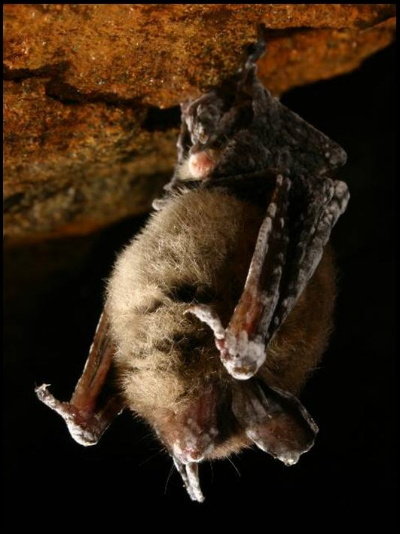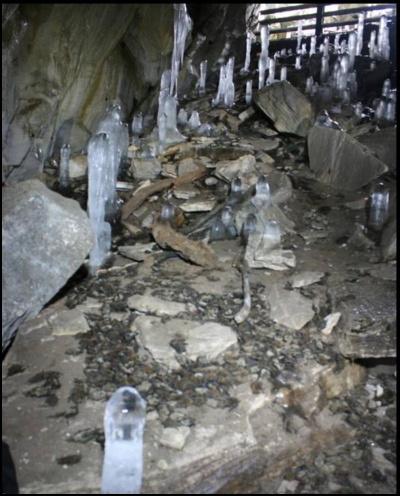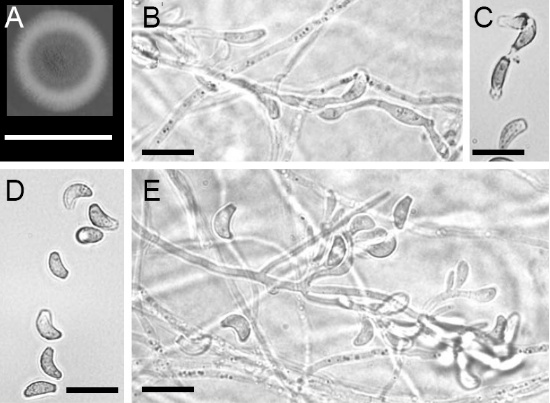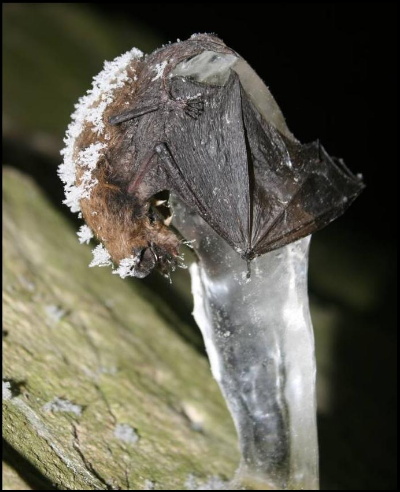 Geomyces destructans,
Geomyces destructans,
a fungus associated with bat White-Nose Syndrome (WNS)
Tom Volk's Fungus of the Month for May 2009
by Tom Volk, David Blehert. Andrea Gargas, Marie Trest, and Martha Christensen.
Please click
TomVolkFungi.net for the rest of Tom Volk's pages on fungi
This month's fungus is a newly described fungus called Geomyces destructans, which is associated with the death of hundreds of thousands of bats in the northeastern United States. Along with several colleagues, we have described this species associated with bat White-Nose Syndrome (WNS) as new to science. You can read our original paper describing Geomyces destructans here. [Gargas, Andrea, Marie Trest, Martha Christensen, Thomas J. Volk, and David Blehert. 2009. Geomyces destructans sp. nov., associated with Bat White-Nose Syndrome. Mycotaxon. 108:147-154.]
Although many people seem to hate bats or at least are afraid of them, it turns out that bats are very helpful to people. Many bats can eat their weight in insects in just one night! Think of that when you are outside being bothered by mosquitoes and other insects. Bats also eat insects that are plant pathogens-- one estimate says that millions of dollars worth of crops are saved from insect damage each year by bats that eat plant pathogenic insects. A single bat may eat up to 10,000 moths and 180,000 mosquito-sized insects in a single year! However, bats may now be in danger.
You have probably heard about bat White-Nose Syndrome (WNS) and the fungus associated with it in the news in recent months. This affliction was first noticed in a cave near Albany, New York in the winter of 2006-2007. Thousands of bats died while they were hibernating in caves. Researchers noticed that the noses and forelimbs of the bats were covered by a fine and delicate mat of fungi. (For an example of this, see the picture to the left.) Rates of mortality were as high as 81-97% in certain hibernacula, a fancy word for the caves and mines in which the bats hibernate. The fungus has since been found in hibernacula from Vermont to Virginia. See http://www.fws.gov/northeast/white_nose.html for a current map. The fungus appears to be easily spread in the hibernacula because the bats congregate together as they roost in the caves.
A fungus has been isolated from bats from all areas in which the bats are dying. As you can see from the photos below, the fungus produces very unusual curved conidia. When first examined, these spores look superficially like a Fusarium species, although the spores of this fungus lack the septa typically found in Fusarium. This species did not seem to fit in anywhere. Thus a large group of researchers led by David Blehert turned to molecular biology for help. They sequenced certain regions of the fungal DNA (the ITS and SSU regions, for those who are interested). They then compared these sequences to published sequences using something called a BLAST search. (See http://blast.ncbi.nlm.nih.gov/Blast.cgi for details on BLAST).
From these BLAST searches and additional sequencing of other species not in the database, Blehert et al. found that this new fungus belongs in the Ascomycota in the family Helotiaceae in the genus Geomyces, although it did not match any known species of Geomyces. You can read all the details of this work here, published online in late 2008, and on paper in early 2009. You can see the phylogenetic trees in our paper here. After this molecular work and a search of the literature for any similar species of Geomyces, there was no other species of Geomyces that has curved conidia, except Geomyces pannorum, which has "occasionally curved" conidia. This fungus was clearly not G. pannorum, so it was decided that this finding represented a new species, a species unknown to science.
Another set of experiments is underway to try to prove that G. destructans is the actual cause of death. Koch's postulates have not yet been fulfilled, so it has not been strictly proven that Geomyces destructans causes death in bats. The histopathology has been well documented, and it is very clear that this fungus is the causal agent of white-nose syndrome cutaneous infection. So far, the correlation between the presence of the fungus and bat death is quite substantial, but *cause* has not yet been proven. Additional work is also underway to try to prevent the disease from spreading further and to try to prevent further infection. Identification and characterization of Geomyces destructans is a major step in solving the bat disease problem.
We hope you enjoyed learning about Geomyces destructans and bat White-Nose Syndrome. This new species appears to be a very destructive fungus. We recommend you read our paper online here. It is a great example of teamwork to solve a problem.
Carey HV, Andrews MT, Martin SL. 2003. Mammalian hibernation: cellular and molecular
responses to depressed metabolism and low temperature. Physiological Review 83(4):
1153-1181.
Gargas, Andrea, Marie Trest, Martha Christensen, Thomas J. Volk, and David Blehert. 2009. Geomyces destructans sp. nov., associated with Bat White-Nose Syndrome. Mycotaxon. 108:147-154. Available online here.
Gargas, Andrea. "Symbiology: Dedicated to understanding the natural world, especially the small stuff" http://symbiology.com/
All the bat photos are courtesy of Alan Hicks, NY Department of Environmental Conservation.
This page was last updated June 18, 2009
Learn more about fungi! Go to Tom Volk's Fungi Home Page --TomVolkFungi.net Return to Tom Volk's Fungus of the month pages listing

 This would allow for quick spread of the fungus as the bats hibernate. There is a great deal of information about WNS online-- We suggest you go to http://www.fort.usgs.gov/WNS/ for a very complete overview. You can find out some very recent information in this testimony before congress, June 4, 2009, here. There are some horrific pictures of dead bats in caves starting about 57 minutes into the video. The photo to the right shows numerous bat carcasses in Aeolus Cave in Vermont (photo by Alan Hicks, NY Department of Environmental Conservation).
This would allow for quick spread of the fungus as the bats hibernate. There is a great deal of information about WNS online-- We suggest you go to http://www.fort.usgs.gov/WNS/ for a very complete overview. You can find out some very recent information in this testimony before congress, June 4, 2009, here. There are some horrific pictures of dead bats in caves starting about 57 minutes into the video. The photo to the right shows numerous bat carcasses in Aeolus Cave in Vermont (photo by Alan Hicks, NY Department of Environmental Conservation).
 Soon after that, David Blehert and Andrea Gargas assembled a team of scientists (including Marie Trest, Martha Christensen, and me) to study the fungus more carefully in order to describe it as a new species. Besides the odd conidia, this new Geomyces species was found to have a very low optimum temperature for growth. Colonies on cornmeal agar and Sabouraud dextrose agar are slow growing and psychrophilic; colony diameter after 16 days 1.0 mm at 3°C (~37°F), 5 mm at 7°C (~45°F), 8mm at 14°C (~57°F), no growth at 24°C (~75°F). These preferred growth temperatures that closely resemble the temperatures found in the bat hibernacula help to explain why G. destructans is probably restricted to growth in caves and other areas where the temperature remains constantly low. Also as bats hibernate, their body temperature drops to a temperature just barely above the ambient cave temperature, falling to the range of 2-10ºC (35-50ºF), allowing growth of this psychrophilic (cold-loving) fungus. (Caption for picture: Geomyces destructans, cultural and microscopic characteristics A. Colony on cornmeal agar after 16 days at 7°C. B. Conidiophores with conidia in short chains. C. Conidia with separating cell. D. Curved conidia. E. Conidiophores showing acute branching. Scale bars: A = 1 cm, B-E = 10 µm)
Soon after that, David Blehert and Andrea Gargas assembled a team of scientists (including Marie Trest, Martha Christensen, and me) to study the fungus more carefully in order to describe it as a new species. Besides the odd conidia, this new Geomyces species was found to have a very low optimum temperature for growth. Colonies on cornmeal agar and Sabouraud dextrose agar are slow growing and psychrophilic; colony diameter after 16 days 1.0 mm at 3°C (~37°F), 5 mm at 7°C (~45°F), 8mm at 14°C (~57°F), no growth at 24°C (~75°F). These preferred growth temperatures that closely resemble the temperatures found in the bat hibernacula help to explain why G. destructans is probably restricted to growth in caves and other areas where the temperature remains constantly low. Also as bats hibernate, their body temperature drops to a temperature just barely above the ambient cave temperature, falling to the range of 2-10ºC (35-50ºF), allowing growth of this psychrophilic (cold-loving) fungus. (Caption for picture: Geomyces destructans, cultural and microscopic characteristics A. Colony on cornmeal agar after 16 days at 7°C. B. Conidiophores with conidia in short chains. C. Conidia with separating cell. D. Curved conidia. E. Conidiophores showing acute branching. Scale bars: A = 1 cm, B-E = 10 µm)
 Since WNS is still relatively new, there are many questions yet to be answered. It is still unclear at this point why Geomyces destructans is starting to show up now. The main hallmark of the disease is that the bats come out of hibernation too early, thus using up their fat reserves before spring and its many insects have arrived. Was the fungus introduced from another country or continent? Has the species always been here, but mutated into a new destructive form? Bats are thought to have lowered immune responses during hibernation torpor (Carey et al. 2003), which may predispose them to infection
by G. destructans. Is there something suddenly wrong with the immune systems of the bats? Much more experimentation has to be done to solve these questions.
Since WNS is still relatively new, there are many questions yet to be answered. It is still unclear at this point why Geomyces destructans is starting to show up now. The main hallmark of the disease is that the bats come out of hibernation too early, thus using up their fat reserves before spring and its many insects have arrived. Was the fungus introduced from another country or continent? Has the species always been here, but mutated into a new destructive form? Bats are thought to have lowered immune responses during hibernation torpor (Carey et al. 2003), which may predispose them to infection
by G. destructans. Is there something suddenly wrong with the immune systems of the bats? Much more experimentation has to be done to solve these questions.
References.
 Blehert DS, Hicks AC, Behr M, Meteyer CU, Berlowski-Zier BM, Buckles EL, Coleman JTH,
Darling SR, Gargas A, Niver R, Okoniewski JC, Rudd RJ, Stone WB. 2009. Bat white-nose
syndrome: an emerging fungal pathogen? Science 323(5911): 227. Available online at
Blehert DS, Hicks AC, Behr M, Meteyer CU, Berlowski-Zier BM, Buckles EL, Coleman JTH,
Darling SR, Gargas A, Niver R, Okoniewski JC, Rudd RJ, Stone WB. 2009. Bat white-nose
syndrome: an emerging fungal pathogen? Science 323(5911): 227. Available online at
http://www.fws.gov/northeast/whitenose/Blehert_et_al_2008_WNS_fungus_total.pdf.
If you have anything to add, or if you have corrections, comments, or recommendations for future FotM's (or maybe you'd like to be co-author of a FotM?), please write to me at
This page and other pages are © Copyright 2009 by Thomas J. Volk, University of Wisconsin-La Crosse.
